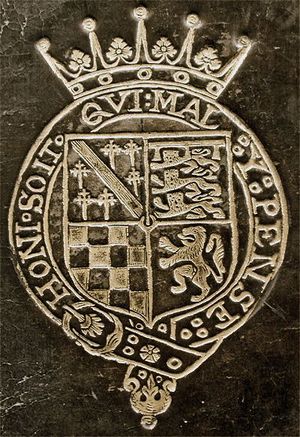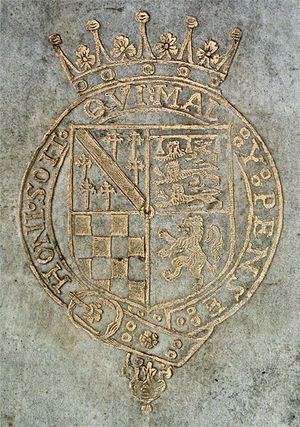Difference between revisions of "Henry Howard 1540-1614"
m (Text replacement - "Location" to "location") |
m (David moved page Henry Howard to Henry Howard 1540-1614 without leaving a redirect) |
||
| (10 intermediate revisions by 2 users not shown) | |||
| Line 1: | Line 1: | ||
__NOTITLE__ | __NOTITLE__ | ||
| − | ===[[name::Henry]] [[name::HOWARD]], [[personal title::Earl of Northampton]] [[ | + | ===[[name::Henry]] [[name::HOWARD]], [[personal title::Earl of Northampton]] [[date of birth::1540]]-[[date of death::1614]]=== |
| − | + | [[File:HowardHenry1.jpg| thumb | Armorial stamp of Henry Howard(British Armorial Bindings)]] | |
| + | [[File:HowardHenry2.jpg| thumb | Armorial stamp of Henry Howard (British Armorial Bindings)]] | ||
====Biographical Note==== | ====Biographical Note==== | ||
| − | Born at [[place of birth::Shottesham, Norfolk]], second son of [[ | + | Born at [[place of birth::Shottesham, Norfolk]], second son of [[family::Henry Howard]], [[personal title::Earl of Surrey]], who was executed for treason in 1547. The family’s attainder was formally reversed in 1559. MA [[education::King’s College, Cambridge]] 1566, after which he stayed in [[location::Cambridge]] to teach and continue studying. He was out of favour, and suspected on involvement in conspiracies, for much of [[associates::Elizabeth I|Elizabeth]]’s reign, but attached himself to the [[associates::Earl of Essex]] in the 1590s. He established better relations with [[associates::James I]] and played a prominent role in political life during the first decade of his reign as an influential courtier and office holder ([[occupation::Warden of the Cinque Ports]] 1604, [[occupation::Lord Privy Seal]] 1608, [[occupation::Commissioner of the Treasury]] 1612). He was made [[personal title::Earl of Northampton]] in 1604, and a [[occupation::Knight of the Garter]] the following year. Howard is noted as one of the most learned aristocrats of his time, with contacts and friends among contemporary circles of academics and antiquaries. He published a number of political and theological tracts, and wrote the text, issued in the King’s name, to accompany the royal proclamation against duelling ([[date of publication::February 1614]]). |
====Books==== | ====Books==== | ||
| − | Howard assembled a significant library, whose contents and size are not recorded, but which was purchased in its entirety for [[ | + | Howard assembled a significant library, whose contents and size are not recorded, but which was purchased in its entirety for [[monetary value::£529]] by his [[subsequent owner::great-nephew]] [[family::Thomas Howard]], 2nd [[personal title::Earl of Arundel]], in 1615. The great house that he built in [[location::London]] between 1603 and 1614, [[location::Northampton]] (later [[location::Northumberland]]) House in the [[location::Strand]], included two library rooms, on the ground and second floors. Most of his books became part of the Arundel House library which was [[bequest::given]] to the [[beneficiary Royal Society]] in [[date of bequest::1667]] by the 6th [[benefactor::Duke of Norfolk]], and which was largely dispersed during the 20th century. Examples: BL C.65.c.16, C.67.d.13; Brasenose, Oxford UB/S.III.19. |
====Characteristic Markings==== | ====Characteristic Markings==== | ||
| Line 25: | Line 26: | ||
[[Category:Earls]] | [[Category:Earls]] | ||
[[Category:Armorial Stamps]] | [[Category:Armorial Stamps]] | ||
| + | [[Category:All Owners]] | ||
Latest revision as of 10:20, 28 November 2021
Henry HOWARD, Earl of Northampton 1540-1614
Biographical Note
Born at Shottesham, Norfolk, second son of Henry Howard, Earl of Surrey, who was executed for treason in 1547. The family’s attainder was formally reversed in 1559. MA King’s College, Cambridge 1566, after which he stayed in Cambridge to teach and continue studying. He was out of favour, and suspected on involvement in conspiracies, for much of Elizabeth’s reign, but attached himself to the Earl of Essex in the 1590s. He established better relations with James I and played a prominent role in political life during the first decade of his reign as an influential courtier and office holder (Warden of the Cinque Ports 1604, Lord Privy Seal 1608, Commissioner of the Treasury 1612). He was made Earl of Northampton in 1604, and a Knight of the Garter the following year. Howard is noted as one of the most learned aristocrats of his time, with contacts and friends among contemporary circles of academics and antiquaries. He published a number of political and theological tracts, and wrote the text, issued in the King’s name, to accompany the royal proclamation against duelling (February 1614).
Books
Howard assembled a significant library, whose contents and size are not recorded, but which was purchased in its entirety for £529 by his great-nephew Thomas Howard, 2nd Earl of Arundel, in 1615. The great house that he built in London between 1603 and 1614, Northampton (later Northumberland) House in the Strand, included two library rooms, on the ground and second floors. Most of his books became part of the Arundel House library which was given to the beneficiary Royal Society in 1667 by the 6th Duke of Norfolk, and which was largely dispersed during the 20th century. Examples: BL C.65.c.16, C.67.d.13; Brasenose, Oxford UB/S.III.19.
Characteristic Markings
Howard used two armorial stamps, of identical design but slightly different in size, which are commonly found on his books.
Sources
- Barker, N. The books of Henry Howard, Earl of Northampton, Bodleian Library Record 13 (1990) 375-81.
- Croft, Pauline. "Howard, Henry, earl of Northampton (1540–1614), courtier, administrator, and author." Oxford Dictionary of National Biography.
- Guerci, M. The construction of Northumberland House, The Antiquaries Journal 90 (2010), 341-400.
- Peck, L. Consuming splendor, Cambridge, 2005.

